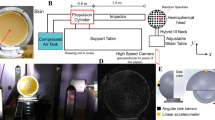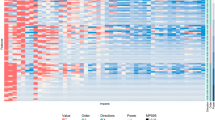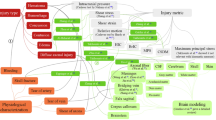Abstract
Successful validation of a head injury model is critical to ensure its biofidelity. However, there is an ongoing debate on what experimental data are suitable for model validation. Here, we report that CORrelation and Analysis (CORA) scores based on the commonly adopted relative brain-skull displacements or recent marker-based strains from cadaveric head impacts may not be effective in discriminating model-simulated whole-brain strains across a wide range of blunt conditions. We used three versions of the Worcester Head Injury Model (WHIM; isotropic and anisotropic WHIM V1.0, and anisotropic WHIM V1.5) to simulate 19 experiments, including eight high-rate cadaveric impacts, seven mid-rate cadaveric pure rotations simulating impacts in contact sports, and four in vivo head rotation/extension tests. All WHIMs achieved similar average CORA scores based on cadaveric displacement (~ 0.70; 0.47–0.88) and strain (V1.0: 0.86; 0.73–0.97 vs. V1.5: 0.78; 0.62–0.96), using the recommended settings. However, WHIM V1.5 produced ~ 1.17–2.69 times strain of the two V1.0 variants with substantial differences in strain distribution as well (Pearson correlation of ~ 0.57–0.92) when comparing their whole-brain strains across the range of blunt conditions. Importantly, their strain magnitude differences were similar to that in cadaveric marker-based strain (~ 1.32–3.79 times). This suggests that cadaveric strains are capable of discriminating head injury models for their simulated whole-brain strains (e.g., by using CORA magnitude sub-rating alone or peak strain magnitude ratio), although the aggregated CORA may not. This study may provide fresh insight into head injury model validation and the harmonization of simulation results from diverse head injury models. It may also facilitate future experimental designs to improve model validation.










Similar content being viewed by others
References
Abaqus, A. Abaqus Online Documentation. Abaqus, 2016.
Alshareef, A., J. S. Giudice, J. Forman, R. S. Salzar, and M. B. Panzer. A novel method for quantifying human in situ whole brain deformation under rotational loading using sonomicrometry. J. Neurotrauma 35:780–789, 2018.
Atsumi, N., Y. Nakahira, E. Tanaka, and M. Iwamoto. Human brain modeling with its anatomical structure and realistic material properties for brain injury prediction. Ann. Biomed. Eng. 46:736–748, 2018.
Bahrami, N., D. Sharma, S. Rosenthal, E. M. Davenport, J. E. Urban, B. Wagner, Y. Jung, C. G. Vaughan, G. A. Gioia, J. D. Stitzel, C. T. Whitlow, and J. A. Maldjian. Subconcussive head impact exposure and white matter tract changes over a single season of youth football. Radiology 281:919–926, 2017.
Bayly, P. V., T. S. Cohen, E. P. Leister, D. Ajo, E. C. Leuthardt, and G. M. Genin. Deformation of the human brain induced by mild acceleration. J. Neurotrauma 22:845–856, 2005.
Bigler, E. D. Systems biology, neuroimaging, neuropsychology, neuroconnectivity and traumatic brain injury. Front. Syst. Neurosci. 10:1–23, 2016.
Cai, Y., S. Wu, W. Zhao, Z. Li, Z. Wu, and S. Ji. Concussion classification via deep learning using whole-brain white matter fiber strains. PLoS ONE 13:e0197992, 2018.
Chan, D., A. K. Knutsen, Y. C. Lu, S. H. Yang, E. Magrath, W. T. Wang, P. V. Bayly, J. A. Butman, and D. L. Pham. Statistical characterization of human brain deformation during mild angular acceleration measured in vivo by tagged MRI. J. Biomech. Eng. 140:1–13, 2018.
Donnelly, B., R. Morgan, and R. Eppinger. Durability, repeatability and reproducibility of the NHTSA side impact dummy. Stapp Car Crash J. 27:299–310, 1983.
Feng, Y., T. M. Abney, R. J. Okamoto, R. B. Pless, G. M. Genin, and P. V. V. Bayly. Relative brain displacement and deformation during constrained mild frontal head impact. J. R. Soc. Interface 7:1677–1688, 2010.
Finan, J. D., S. N. Sundaresh, B. S. Elkin, G. M. Mckhann-Ii, B. Morrison-Iii, G. M. McKhann, and B. Morrison. Regional mechanical properties of human brain tissue for computational models of traumatic brain injury. Acta Biomater. 55:333–339, 2017.
Forte, A. E., S. M. Gentleman, and D. Dini. On the characterization of the heterogeneous mechanical response of human brain tissue. Biomech. Model. Mechanobiol. 16:907–920, 2017.
Ganpule, S., N. P. Daphalapurkar, K. T. Ramesh, A. K. Knutsen, D. L. Pham, P. V. Bayly, and J. L. Prince. A three-dimensional computational human head model that captures live human brain dynamics. J. Neurotrauma 34:2154–2166, 2017.
Garimella, H. T., and R. H. Kraft. Modeling the mechanics of axonal fiber tracts using the embedded finite element method. Int. J. Numer. Method. Biomed. Eng. 33:26–35, 2017.
Giordano, C., and S. Kleiven. Evaluation of axonal strain as a predictor for mild traumatic brain injuries using finite element modeling. Stapp Car Crash J. 58:29–61, 2014.
Giordano, C., and S. Kleiven. Development of an unbiased validation protocol to assess the biofidelity of finite element head models used in prediction of traumatic brain injury. Stapp Car Crash J. 60:363–471, 2016.
Giudice, J. S., W. Zeng, T. Wu, A. Alshareef, D. F. Shedd, and M. B. Panzer. An analytical review of the numerical methods used for finite element modeling of traumatic brain injury. Ann. Biomed. Eng. 47:1855–1872, 2019.
Guettler, A. J. Quantifying the response of relative brain/skull motion to rotational input in the PMHS Head. 2017. https://vtechworks.lib.vt.edu/bitstream/handle/10919/82400/Guettler_AJ_T_2018.pdf?sequence=1.
Guettler, A. J., R. Ramachandra, J. Bolte, and W. N. Hardy. Kinematics response of the PMHS brain to rotational loading of the head: development of experimental methods and analysis of preliminary data. No. 2018-01-0547. SAE Technical Paper, 2018. https://doi.org/10.4271/2018-01-0547.
Hardy, W. Response of the human cadaver head to impact. PhD Dissertation, Wayne State University, Detroit, MI, 2007.
Hardy, W. N. N., C. D. Foster, M. J. Mason, K. H. Yang, A. I. King, and S. Tashman. Investigation of head injury mechanisms using neutral density technology and high-speed biplanar X-ray. Stapp Car Crash J. 45:337–368, 2001.
Hardy, W. N., M. J. Mason, C. D. Foster, C. S. Shah, J. M. Kopacz, K. H. Yang, A. I. King, J. Bishop, M. Bey, W. Anderst, and S. Tashman. A study of the response of the human cadaver head to impact. Stapp Car Crash J. 51:17–80, 2007.
ISO/TR 9790. The International Organization for Standardization (ISO). Road vehicles—anthropomorphic side impact dummy—lateral impact response requirements to assess the biofi- delity of the dummy.
Ji, S., H. Ghadyani, R. Bolander, J. Beckwith, J. C. Ford, T. McAllister, L. A. Flashman, K. D. Paulsen, K. Ernstrom, S. Jain, R. Raman, L. Zhang, and R. M. Greenwald. Parametric comparisons of intracranial mechanical responses from three validated finite element models of the human head. Ann. Biomed. Eng. 42:11–24, 2014.
Ji, S., W. Zhao, J. C. Ford, J. G. Beckwith, R. P. Bolander, R. M. Greenwald, L. A. Flashman, K. D. Paulsen, and T. W. McAllister. Group-wise evaluation and comparison of white matter fiber strain and maximum principal strain in sports-related concussion. J. Neurotrauma 32:441–454, 2015.
Kimpara, H., Y. Nakahira, M. Iwamoto, K. Miki, K. Ichihara, S. Kawano, and T. Taguchi. Investigation of anteroposterior head-neck responses during severe frontal impacts using a brain-spinal cord complex FE model. Stapp Car Crash J. 50:509–544, 2006.
King, A. I., K. H. Yang, L. Zhang, W. W. N. Hardy, and D. C. Viano. Is head injury caused by linear or angular acceleration?. 2003 IRCOBI conference. Vol. 12. Lisbon.
Kleiven, S. Predictors for traumatic brain injuries evaluated through accident reconstructions. Stapp Car Crash J. 51:81–114, 2007.
Knutsen, A. K., E. Magrath, J. E. McEntee, F. Xing, J. L. Prince, P. V. Bayly, J. A. Butman, and D. L. Pham. Improved measurement of brain deformation during mild head acceleration using a novel tagged MRI sequence. J. Biomech. 47:3475–3481, 2014.
Lu, Y. C., N. P. Daphalapurkar, A. K. Knutsen, J. Glaister, D. L. Pham, J. A. Butman, J. L. Prince, P. V. Bayly, and K. T. Ramesh. A 3D computational head model under dynamic head rotation and head extension validated using live human brain data, including the falx and the tentorium. Ann. Biomed. Eng. 2019. https://doi.org/10.1007/s10439-019-02226-z.
MacManus, D. B., B. Pierrat, J. G. Murphy, and M. D. Gilchrist. Region and species dependent mechanical properties of adolescent and young adult brain tissue. Sci. Rep. 7:1–12, 2017.
Mao, H., L. Zhang, B. Jiang, V. Genthikatti, X. Jin, F. Zhu, R. Makwana, A. Gill, G. Jandir, A. Singh, and K. Yang. Development of a finite element human head model partially validated with thirty five experimental cases. J. Biomech. Eng. 135:111002–111015, 2013.
Miller, L. E., J. E. Urban, and J. D. Stitzel. Development and validation of an atlas-based finite element brain model model. Biomech Model. 15:1201–1214, 2016.
Miller, L. E., J. E. Urban, and J. D. Stitzel. Validation performance comparison for finite element models of the human brain. Comput. Methods Biomech. Biomed. Engin. 5842:1–16, 2017.
Mori, S., K. Oishi, H. Jiang, L. Jiang, X. Li, K. Akhter, K. Hua, A. V. Faria, A. Mahmood, R. Woods, A. W. Toga, G. B. Pike, P. R. Neto, A. Evans, J. Zhang, H. Huang, M. I. Miller, P. van Zijl, and J. Mazziotta. Stereotaxic white matter atlas based on diffusion tensor imaging in an ICBM template. Neuroimage 40:570–582, 2008.
Morrison, B., B. S. Elkin, J.-P. Dollé, and M. L. Yarmush. In vitro models of traumatic brain injury. Annu. Rev. Biomed. Eng. 13:91–126, 2011.
Ning, X., Q. Zhu, Y. Lanir, and S. S. Margulies. A transversely isotropic viscoelastic constitutive equation for brainstem undergoing finite deformation. J. Biomech. Eng. 128:925–933, 2006.
Peden, M., R. Scurfield, D. Sleet, D. Mohan, A. A. Hyder, E. Jarawan, and C. Mathers. World report on road traffic injury prevention. Technical report, World Health Organization, 2004.
Rowson, S., and S. M. Duma. Brain injury prediction: assessing the combined probability of concussion using linear and rotational head acceleration. Ann. Biomed. Eng. 41:873–882, 2013.
Rowson, S., S. M. Duma, J. G. Beckwith, J. J. Chu, R. M. Greenwald, J. J. Crisco, P. G. Brolinson, A.-C. C. Duhaime, T. W. McAllister, and A. C. Maerlender. Rotational head kinematics in football impacts: an injury risk function for concussion. Ann. Biomed. Eng. 40:1–13, 2012.
Sabet, A. A., E. Christoforou, B. Zatlin, G. M. Genin, and P. V. Bayly. Deformation of the human brain induced by mild angular head acceleration. J. Biomech. 41:307–315, 2008.
Scott, G. G., S. S. Margulies, and B. Coats. Utilizing multiple scale models to improve predictions of extra-axial hemorrhage in the immature piglet. Biomech. Model. Mechanobiol. 15:1101–1119, 2016.
Shattuck, D., M. Mirza, V. Adisetiyo, G. Hojatkashani, C. Salamon, and K. Narr. Construction of a 3D probabilistic atlas of human cortical structures. Neuroimage 39:1064–1080, 2008.
Stemper, B. D., et al. Comparison of head impact exposure between concussed football athletes and matched controls: evidence for a possible second mechanism of sport-related concussion. Ann. Biomed. Eng 2018. https://doi.org/10.1007/s10439-018-02136-6.
Takhounts, E. G. G., M. J. J. Craig, K. Moorhouse, J. McFadden, and V. Hasija. Development of brain injury criteria (Br IC). Stapp Car Crash J. 57:243–266, 2013.
Takhounts, E. G., R. H. Eppinger, J. Q. Campbell, R. E. Tannous, E. D. Power, and L. S. Shook. On the development of the SIMon finite element head model. Stapp Car Crash J. 47:107–133, 2003.
Takhounts, E. G., S. A. Ridella, R. E. Tannous, J. Q. Campbell, D. Malone, K. Danelson, J. Stitzel, S. Rowson, and S. Duma. Investigation of traumatic brain injuries using the next generation of simulated injury monitor (SIMon) finite element head model. Stapp Car Crash J. 52:1–31, 2008.
Wu, T., A. Alshareef, J. S. Giudice, and M. B. Panzer. Explicit modeling of white matter axonal fiber tracts in a finite element brain model. Ann. Biomed. Eng 2019. https://doi.org/10.1007/s10439-019-02239-8.
Wu, S., W. Zhao, K. Ghazi, and S. Ji. Convolutional neural network for efficient estimation of regional brain strains. Sci. Rep. 9:17326, 2019.
Wu, S., W. Zhao, B. Rowson, S. Rowson, and S. Ji. A network-based response feature matrix as a brain injury metric. Biomech. Model Mechanobiol. 2019. https://doi.org/10.1007/s10237-019-01261-y.
Yang, K. H., J. Hu, N. A. White, A. I. King, C. C. Chou, and P. Prasad. Development of numerical models for injury biomechanics research: a review of 50 years of publications in the Stapp Car Crash Conference. Stapp Car Crash J. 50:429–490, 2006.
Yang, K. H., and H. Mao. Modelling of the Brain For Injury Simulation And Prevention BT. In: Biomechanics of the Brain, edited by K. Miller. Cham: Springer International Publishing, 2019.
Zhang, L., and T. Gennarelli. Mathematical modeling of diffuse brain injury: correlations of foci and severity of brain strain with clinical symptoms and pathology., 2011.
Zhao, W., Y. Cai, Z. Li, and S. Ji. Injury prediction and vulnerability assessment using strain and susceptibility measures of the deep white matter. Biomech. Model. Mechanobiol. 16:1709–1727, 2017.
Zhao, W., B. Choate, and S. Ji. Material properties of the brain in injury-relevant conditions: experiments and computational modeling. J. Mech. Behav. Biomed. Mater. 80:222–234, 2018.
Zhao, W., J. C. Ford, L. A. Flashman, T. W. McAllister, and S. Ji. White matter injury susceptibility via fiber strain evaluation using whole-brain tractography. J. Neurotrauma 33:1834–1847, 2016.
Zhao, W., and S. Ji. White matter anisotropy for impact simulation and response sampling in traumatic brain injury. J. Neurotrauma 36:250–263, 2019.
Zhao, W., and S. Ji. Mesh convergence behavior and the effect of element integration of a human head injury model. Ann. Biomed. Eng. 47:475–486, 2019.
Zhou, Z., X. Li, and S. Kleiven. Fluid–structure interaction simulation of the brain–skull interface for acute subdural haematoma prediction. Biomech. Model. Mechanobiol. 2018. https://doi.org/10.1007/s10237-018-1074-z.
Zhou, Z., X. Li, S. Kleiven, and W. N. Hardy. A reanalysis of experimental brain strain data: implication for finite element head model validation. Stapp Car Crash J. 62:1–26, 2018.
Zhou, Z., X. Li, S. Kleiven, and W. N. Hardy. Brain strain from motion of sparse markers. Stapp Car Crash J. 63:1–27, 2019.
Zou, H., J. P. Schmiedeler, and W. N. Hardy. Separating brain motion into rigid body displacement and deformation under low-severity impacts. J. Biomech. 40:1183–1191, 2007.
Acknowledgments
Funding is provided by the NIH Grant R01 NS092853.
Conflict of interest
No competing financial interests exist.
Author information
Authors and Affiliations
Corresponding author
Additional information
Associate Editor Joel D. Stitzel oversaw the review of this article.
Publisher's Note
Springer Nature remains neutral with regard to jurisdictional claims in published maps and institutional affiliations.
Electronic supplementary material
Below is the link to the electronic supplementary material.
Rights and permissions
About this article
Cite this article
Zhao, W., Ji, S. Displacement- and Strain-Based Discrimination of Head Injury Models across a Wide Range of Blunt Conditions. Ann Biomed Eng 48, 1661–1677 (2020). https://doi.org/10.1007/s10439-020-02496-y
Received:
Accepted:
Published:
Issue Date:
DOI: https://doi.org/10.1007/s10439-020-02496-y




